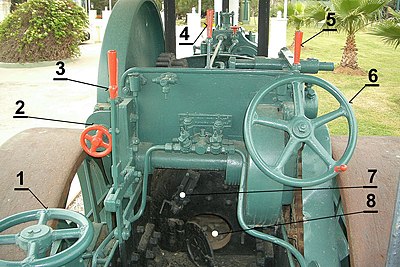Steamroller

A steam roller is a roller for civil engineering and road construction, which is driven by steam power by means of a steam engine. It takes care of the static compaction of the road surface immediately after its installation by the load of the vehicle.
history
Steam rollers were developed and used successfully in the early 1860s. They marked the step towards industrialization and replaced the previously used rollers, mostly drawn by horses. Thanks to their proverbial power (“like a steam roller”) and their much higher weight, they achieved a better compaction of the subsoil. Steam rollers were not only used as compaction equipment, but also carried out a variety of pulling and transport tasks on construction sites, as other motor-driven tractors were not yet available.
Steam rollers had their wedding around the turn of the century. By the middle of the 20th century, steam rollers were increasingly being replaced by rollers with diesel engine drives, which were developed around 1910. However, some steam rollers were still in commercial use until the 1970s.
Today steamrollers can be seen mainly in museums. A few working examples are maintained by fans of steam technology and presented at appropriate show events.
technology
The steam rollers are in principle self-propelled locomobiles in which the wheels are replaced by rollers. Because the front, continuous roller could not be arranged under the smoke chamber , it was attached to a smoke chamber extension.
The chassis of the steam roller consisted of a long boiler , the standing boiler at the back, as well as the smoke chamber and the front structure, which were firmly connected to each other. At the rear, the rear axle, the driver's cab and the tender were attached to the standing boiler. It is driven by a single or multi-cylinder steam engine and a flywheel at the rear . The linkage of the cruise control is located in between. The rear wheels are driven by three gear ratios , the first stage of which normally has two gears . The steering takes place by means of a worm gear and a chain acting on the front roller . Often a block brake acting on the flywheel is attached.
- Technical details of the steam engine Aveling & Porter from Rochester , built in about 1902
View of the
driver's cab 1 Brake wheel (serves as service and parking brake )
2 Hand wheel of the steam engine brake
3 Lever for reversing (forwards-backwards)
4 Lever of the speed control
5 Shift lever (left first gear, middle idle , right second gear)
6 Steering wheel
7 Sight glass of the water level indicator
8 Fire holeView of the steam engine
1 control housing ( valve body )
2 steam cylinder
3 piston rod
4 crosshead
5 connecting rod
6 crank
7 driving the slide valve
8 lever and linkage of the speed controller
9 gear pair of the first gear (first gear)
10 pair of gears of the second gear
11 shift fork
12 pinion of the second reduction
Manufacturer
Steam rollers were developed in England, and English manufacturers such as Aveling & Porter , John Fowler & Co. , Marshall, Sons & Co. or Wallis & Steevens have long been leaders in Europe and the world.
In the United States, the Buffalo-Springfield Company was the best known of many manufacturers. In Europe, besides the United Kingdom, steam rollers were mainly manufactured in the Czech Republic, Sweden, Germany and the Netherlands.
Well-known German manufacturers were Kemna , Ruthemeyer , Zettelmeyer , Henschel , Maffei , Lanz or Kaelble .



